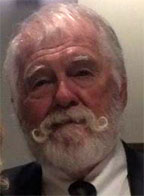
Don Morgan
Suspended Animation #398
Donald Lester Morgan was born May 16th, 1938 in Broad Top, Pennsylvania and died in his home in Tehachapi, California, on March 31st, 2019.
Morgan grew up in Mechanicsburg, Pennsylvania, and joined the Navy three days after graduation from high school. After his time in the Navy he went to Pratt Institute and majored in industrial design, although he always wanted to draw cartoons.
As soon as he graduated, he moved out to Southern California where many of the animation studios were located. He went to apply for a job at Bob Clampett’s studio that had animated the Beany and Cecil television series only to discover that another animation studio was operating in the same space and was run by Dave and Phyllis Bounds Detiege to produce an independent animated feature film, The Man from Button Willow (1965).
He was hired as an assistant animator to Ken Hultgren and, due to his background in industrial design, was encouraged by Phyllis Detiege to go into doing layout. His mentors on the film were Ernie Nordli, Tony Rivera and Bruce Bushman.
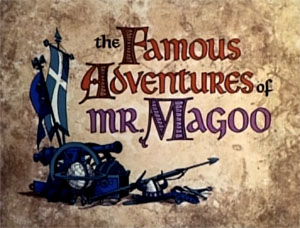 When his layout responsibilities ended, Tony Rivera recommended Morgan to Abe Levitow at UPA for the prime-time animated series The Famous Adventures of Mr. Magoo.
When his layout responsibilities ended, Tony Rivera recommended Morgan to Abe Levitow at UPA for the prime-time animated series The Famous Adventures of Mr. Magoo.
Along with Jacques Rupp, Morgan worked on the clever title sequence for the series. In addition, he did the individual episode titles for and worked on the Moby Dick, Frankenstein and Dick Tracy episodes among others. During this time, he worked freelance on the Magoo GE commercials as well.
When the series ended and the staff was laid off, Abe Levitow went over to Tower 12 Productions at MGM and brought over Morgan to lay out the Chuck Jones Tom and Jerry cartoons under the guidance of Maurice Noble.
Morgan worked on How the Grinch Stole Christmas (1966) including the sleigh sequence on top of the mountain among other scenes. He laid out The Pogo Special Birthday Special (1969) by brush inking in the style of Walt Kelly. Bob Inman did the colored backgrounds from those layouts.
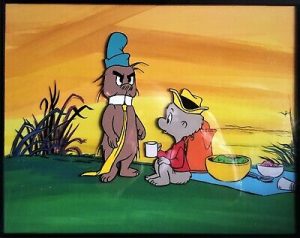 Kelly wrote the special, did some animation and supplied the voices for the characters of Albert, P.T. Bridgeport and Howland Owl as well as being the co-producer.
Kelly wrote the special, did some animation and supplied the voices for the characters of Albert, P.T. Bridgeport and Howland Owl as well as being the co-producer.
“It was pretty damned inconvenient commuting to the (west) coast on alternate weeks and the picture itself was a lot of trouble,” Kelly told Editor & Publisher magazine for its April 19, 1969 issue.
The half hour special premiered on NBC on May 18,1969 and received strong ratings. The Nielson ratings estimated that approximately fifteen million people watched the show that night.
However, as much as he respected director and co-producer Chuck Jones and his work, Kelly was unhappy at how Jones was handling his beloved characters. In general, he felt that Jones had hijacked his story and was cutting out all the gags and shifting the story to a more sentimental tone. At one point Kelly and Jones stopped talking directly to each other and used animator Ben Washam as their go-between.
Kelly found a sympathetic ear several nights from Morgan over drinks at the famous Hollywood Roosevelt Hotel where Kelly was staying in Hollywood.
Kelly had liked Morgan and his art which is why he handpicked the artist to ghost the Pogo strip. One of Morgan’s many accomplishments was that he ghosted the Pogo daily and Sunday strips from 10/15/73 – 12/25/73 and then after a week’s break again from 1/3/74 – 11/23/74.

A POGO strip by Don Morgan.
In addition, working on the special, Kelly met Selby Daley. As Selby remembered in an interview with animator Nancy Beiman in 1984 that appeared in Cartoonist PROfiles magazine, “I was working as a freelancer out of the Cartoonist’s Guild office and Frank Braxton asked me to work as his assistant at MGM because I wanted a steady income. He had cancer and had to go back into the hospital so I was at MGM without any particular person to work with. Kelly and I met and he asked that I be his assistant.
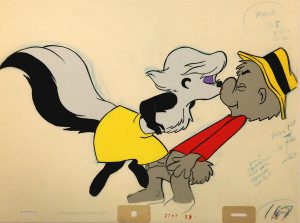 “My duty was to check on all the people who were drawing the characters for the Pogo TV special and to make sure that they were all drawing them the same because we didn’t have model sheets. Kelly didn’t want the characters pinned down.
“My duty was to check on all the people who were drawing the characters for the Pogo TV special and to make sure that they were all drawing them the same because we didn’t have model sheets. Kelly didn’t want the characters pinned down.
“I got the essence of what Kelly wanted from him and I was the liaison between him and the staff. Incidentally, when this special was completed and we saw it on TV, Kelly was very disappointed with it. It was so unlike a real Kelly product that he decided that he and I would make another film on our own.
“In 1973, Kelly had been too ill to draw for some time and the syndicate was after him to get a crew together. He didn’t know anybody in New York who could draw the characters (it turned out later that one of his assistants Henry Shikuma could do them quite well), but Kelly hired a guy from California (Don Morgan) who had worked on the MGM special.
“He did a few dailies to stories that Kelly had already written when suddenly there was a week’s work that was indescribably awful. It seems that due to personal problems the artist had farmed it out to someone else who did it in a very Japanese style. I couldn’t continue using his work if he was going to be farming it out so I started doing it myself.”
It was animator Willie Ito who stepped in for the strips from 12/26/73 – 1/2/74.
As Ito recalled, “Walt (Kelly) took ill and was unable to complete his commitment. So, Walt figured that Don Morgan is the only one capable of following through. But then Don came to me, and said ‘I just promised my son Ethan we’re going to go off to the woods for a vacation, and I can’t break his heart. So, can you help me out? So, can you help me out with a week of dailies?’
“I thought I’d have to use a brush, as Walt did — but I didn’t have time to practice with a brush. So, I used my Pentel pen, instead. And I thought I did a passable job. And I guess Don was able to pass it off. But a few years later, I learned that Shelby was really annoyed, and said ‘It looks like it was done by some Japanese artist in Japan.’ And I said, ‘Well, she’s half-right’.”
During the time he worked on the Pogo strip, Morgan worked with Ralph Bakshi on three features (for instance designing the nymphets in Coonskin) before moving over to Hanna-Barbera as a layout supervisor on shows like The Smurfs.
Disney Legend Floyd Norman recalled to me, “Don was my boss at Hanna-Barbera’s Layout Department back in the 1970s, and I enjoyed working with him. Don was a delightful fellow and always fun to chat with.
 “As I’m sure you already know, Don was proud of his reputation as a ‘Mountain Man’, and often talked about living in the hills away from noisy, urban centers. He could be grumpy on occasion, but I enjoyed his managing style, which was mainly keeping Bill Hanna happy.
“On occasion, Don would bring in beautiful Pogo originals. I had no idea he was ghosting the strip back in those days because Don never spoke of it.
“As I’m sure you already know, Don was proud of his reputation as a ‘Mountain Man’, and often talked about living in the hills away from noisy, urban centers. He could be grumpy on occasion, but I enjoyed his managing style, which was mainly keeping Bill Hanna happy.
“On occasion, Don would bring in beautiful Pogo originals. I had no idea he was ghosting the strip back in those days because Don never spoke of it.
As I recall, he had quite a few Walt Kelly originals. I loved pouring over the art, but we never spoke of Don’s relationship with Walt Kelly.”
Morgan later worked at other animation studios including Sanrio and Dreamworks on feature films before retiring in 2003.
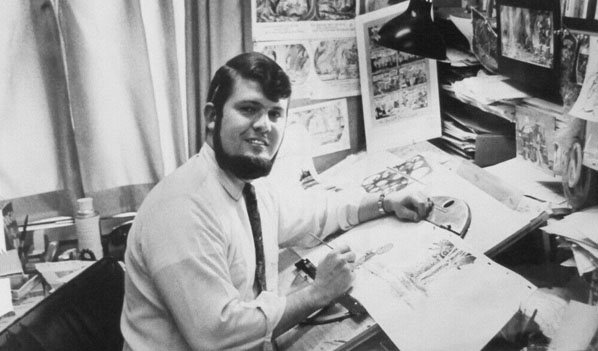
Don Morgan working on the Jones’ Pogo special


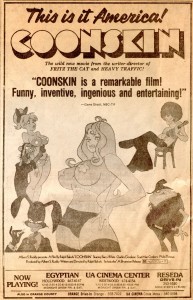
 Jim Korkis is an internationally respected animation historian who in recent years has devoted his attention to the many worlds of Disney. He was a columnist for a variety of animation magazines. With his former writing partner, John Cawley, he authored several animation related books including The Encyclopedia of Cartoon Superstars, How to Create Animation, Cartoon Confidential and Get Animated’s Animation Art Buyer’s Guide. He taught animation classes at the Disney Institute in Florida as well as instructing classes on acting and animation history for Disney Feature Animation: Florida.
Jim Korkis is an internationally respected animation historian who in recent years has devoted his attention to the many worlds of Disney. He was a columnist for a variety of animation magazines. With his former writing partner, John Cawley, he authored several animation related books including The Encyclopedia of Cartoon Superstars, How to Create Animation, Cartoon Confidential and Get Animated’s Animation Art Buyer’s Guide. He taught animation classes at the Disney Institute in Florida as well as instructing classes on acting and animation history for Disney Feature Animation: Florida.




















































Willie Ito’s page on the Lambiek Comiclopedia has a Pogo daily from 1 January 1974, which is presumably one of the dailies that he ghosted for Don Morgan. It looks perfectly fine to me — far from “indescribably awful” — but then I don’t have Selby Daley’s professional eye. Certainly there’s nothing glaringly “Japanese” about it. Lambiek also contends that Ito worked on the Pogo special (he isn’t credited), and that Walt Kelly engaged both him and Morgan to ghost the comic strip; it says that Kelly was grateful to them for taking his side in disputes with Chuck Jones. But Ito’s quote above doesn’t bear this out. I’m not familiar with the Lambiek site and don’t know enough about the subject matter to be able to vouch for its accuracy.
Although in those days “made in Japan” often meant shoddy and substandard, Selby doesn’t seem to have had any anti-Japanese sentiment. Kelly’s longtime assistant Henry Shikuma was Japanese-American, and Selby kept him on when she drew the Pogo comic strip after Kelly’s death.
But if there really is any manga-style Pogo artwork out there, I would LOVE to see it!
Considering that Walt Kelly died only three days after the run of Morgan’s strips began, the timing of Kelly’s death is eerie. Of course, it’s not as eerie as when Charles Schulz died the night before the publication of his last PEANUTS strip. But it’s eerie, nonetheless.
Such a gift these people had. I couldn’t be more jealous (not unbearably, however; usually it’s enough just to bask in their talent).
I just discovered Pogo. Love it!
I lucked out. I met Don on my first day at Hanna-Barbera in 1973. Don decided I was worth mentoring. He showed me tricks of the trade in character design, staging, background layout and how to survive as an artist in the Business.
“Become a coyote or a crow,” he used to say. “Don’t specialize and become an exotic parrot.”
Don encouraged me to start inking my drawings, which I did (with a Winsor & Newton Series 7 #3 Sable, at his suggestion). Don gave me copies of his Pogo dailies at actual size, to learn his inking style, which was, of course, a perfect imitation of Walt Kelly’s!
I followed Don to Bakshi then onwards to San Rio. Finally, going solo, I was hired at Disney, where I found a home. I was exhausted from constantly worrying about the next job. All of my employment, before Disney, was either seasonal or project-based. I encouraged Don to join Disney, too (which he could have done years before I met him). He would have been brilliant in story development and production layout in Feature Animation. But for some reason –– I’ll never know Don’s motive –– he wanted to stay in Saturday Morning TV. Don was deep file.